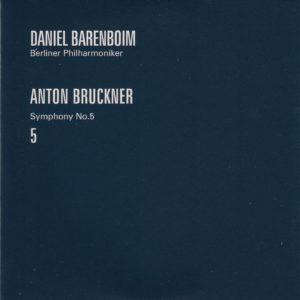 This morning, I am listening to Anton Bruckner’s Symphony No. 5 in B Flat Major (WAB 105), nicknamed “Pizzicato Symphony” or “Tragic,” interpreted by Argentine-born pianist and conductor Daniel Barenboim (1942-), whom I saw conduct the Staatskapelle Berlin in a performance of Bruckner’s Eighth at Carnegie Hall on January 28th of this year.
This morning, I am listening to Anton Bruckner’s Symphony No. 5 in B Flat Major (WAB 105), nicknamed “Pizzicato Symphony” or “Tragic,” interpreted by Argentine-born pianist and conductor Daniel Barenboim (1942-), whom I saw conduct the Staatskapelle Berlin in a performance of Bruckner’s Eighth at Carnegie Hall on January 28th of this year.
NOTE: I have two Barenboim CD box sets for this leg of my Bruckner journey. The first (which I’ll call the “Blue Box”) is on the Warner Classics label. The second (which I’ll call the “Pink Box”) is on the Deutsche Grammophon label. The performances in the Blue Box were recorded in the 1990s. The performances in the Pink Box were recorded much more recently, 2012 and 2010.
So…alpha by conductor, then chronological by dates of performance.
That’s the plan.
Because today’s recording comes from the Blue Blox, Barenboim’s orchestra for this performance is the Berliner Philharmoniker. And the music label is Warner Classics, which was awarded “Label of the Year” at the 2016 Gramophone Awards in London last October.
If you want to know what I thought of Maestro Barenboim’s (“Blue Box”) interpretation of Bruckner’s First in this leg of my journey, visit Day 1.
If you want to know what I thought of Maestro Barenboim’s (“Blue Box”) interpretation of Bruckner’s Second in this leg of my journey, visit Day 6.
If you want to know what I thought of Maestro Barenboim’s (“Blue Box”) interpretation of Bruckner’s Third in this leg of my journey, visit Day 11.
If you want to know what I thought of Maestro Barenboim’s (“Blue Box”) interpretation of Bruckner’s Fourth in this leg of my journey, visit Day 17.
According to its entry on Wikipedia,
The Symphony No. 5 in B-flat major (WAB 105) of Anton Bruckner was written in 1875–1876, with a few minor changes over the next few years. It was first performed in public on two pianos by Joseph Schalk and Franz Zottmann on 20 April 1887 at the Bösendorfersaal in Vienna. The first orchestral performance – in a non-authenticated version (‘Schalk-version’), a.o. with a changed orchestration in a Wagnerian fashion and with omitting 122 bars of the finale – was conducted by Franz Schalk in Graz on 8 April 1894 (Bruckner was sick and unable to attend: he never heard this symphony performed by an orchestra). It was dedicated to Karl von Stremayr, minister of education in the Austro-Hungarian Empire.
The symphony is sometimes referred to as the “Tragic”, “Church of Faith”, or “Pizzicato” symphony.
The symphony was written at a time of much trouble and disillusionment during the composer’s life, a court suit (from which he was exonerated), and a reduction in salary. It is not outwardly a work of storm and stress, but it is a piece of “working out”, one of his most contrapuntally intricate works.
Here are the objective aspects of today’s recording:
 Bruckner’s Symphony No. 5 in B Flat Major (WAB 105), composed 1875–1876
Bruckner’s Symphony No. 5 in B Flat Major (WAB 105), composed 1875–1876
Daniel Barenboim conducts
Barenboim used the “1878/90 version,” according to the CD sleeve
Berliner Philharmoniker plays
The symphony clocks in at 72:02
This was recorded in Berlin, Germany, in October of 1992
Barenboim was 50 when he conducted it
Bruckner was 52 when he finished composing it the first time (he revised it after that)
This recording was released on the Warner Classics label
Bruckner wrote his symphonies in four movements. The time breakdown of this one (Symphony No. 5 in B Flat Major), from this particular conductor (Barenboim) and this particular orchestra (Berliner Philharmoniker) is as follows:
I. Adagio — Allegro……………………………………………………………………..20:13
II. Adagio – Sehr langsam. (Very slowly)……………………………………..16:20
III. Scherzo – Molto vivace…………………………………………………………..12:15
IV. Finale (Adagio) — Allegro moderato……………………………………..22:59
Total Time: 72:02
From the superb liner notes written by Hans Christian Schmidt-Banse,
From beginning to end, the work is based to an almost unprecedented degree on a single motivic cell first started in the slow introduction. Fromt its opening bars onward, the symphony leads irresistibly toward the elaborate, exaltedly hymn-like Finale, which, in turn, makes a significant nod to Beethoven’s Ninth at the beginning of the fourth movement. Material from the three previous movements passes in review, in literal quotation. Furthermore, this final movement, which sounds like a broadly conceived story of redemption is organized in a fundamentally different way to the others.
Okay. Now, here are the subjective aspects:
My Rating:
Recording quality: 5
Overall musicianship: 5
CD liner notes: 5 (a heavy booklet, 1/4-inch thick with lengthy essays translated into English, French, German, and what appears to be Portuguese)
How does this make me feel: 5
Ahhhh. Now this is how a symphony is supposed to sound.
For a DDD (all digital recording) this is exceptional. DDD recordings used to be brittle, too crisp, not warm. They’ve come a long way, baby.
From the opening movement, I was sucked in and held captive. Big sound. Cavernous, almost. Massive.
And the Scherzo! Powerful doesn’t even begin to describe it. Monstrous. The first two or three minutes, alone, are worth the price of admission.
This is an excellent recording of a masterful performance.
The only movement I’m not as ga-ga over is the Adagio (Movement II). The rest of this is astounding, right up to the timpani-rolling Finale.
“Huzzah!”
